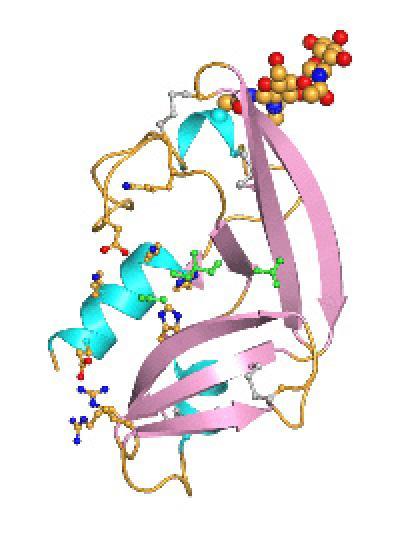A synthetic version of a molecule found in the egg cells of the Northern Leopard frog (Rana pipiens) could provide the world with the first drug treatment for brain tumours.
Known as Amphinase, the molecule recognises the sugary coating found on a tumour cell and binds to its surface before invading the cell and inactivating the RNA it contains, causing the tumour to die.
Although it could potentially be used as a treatment for many forms of cancer, Amphinase offers greatest hope in the treatment of brain tumours, for which complex surgery and chemotherapy are the only current treatments. Amphinase molecule. Credit: Professor Ravi Acharya, University of Bath
Amphinase molecule. Credit: Professor Ravi Acharya, University of Bath
“This is a very exciting molecule,” said Professor Ravi Acharya, from the Department of Biology & Biochemistry at the University of Bath.
“It is rather like Mother Nature’s very own magic bullet for recognising and destroying cancer cells.
“It is highly specific at hunting and destroying tumour cells, is easily synthesised in the laboratory and offers great hope as a therapeutic treatment of the future.”
Amphinase is a version of a ribonuclease enzyme that has been isolated from the oocytes (egg cells) of the Northern Leopard frog.
Ribonucleases are a common type of enzyme found in all organisms. They are responsible for tidying up free-floating strands of RNA cells by latching on to the molecule and cutting it into smaller sections.
In areas of the cell where the RNA is needed for essential functions, ribonucleases are prevented from working by inhibitor molecules. But because Amphinase is an amphibian ribonuclease, it can evade the mammalian inhibitor molecules to attack the cancer cells.
As a treatment, it is most likely to be injected into the area where it is needed. It will have no effect on other cells because it is only capable of recognising and binding to the sugar coating of tumour cells.
“Amphinase is in the very early stages of development, so it is likely to be several years and many trials before it could be developed into a treatment for patients,” said Professor Acharya and his colleagues Drs Umesh Singh and Daniel Holloway.
“Having said that, the early data is promising and through this study we have provided the kind of information needed if approval for use is requested in the future.”
Amphinase is the second anti-tumour ribonuclease to be isolated by Alfacell Corporation from Rana pipiens oocytes.
The other, ONCONASE(R) (ranpirnase), is currently in late-stage clinical trials as a treatment for unresectable malignant mesothelioma, a rare and fatal form of lung cancer, and in Phase I/II clinical trials in non-small cell lung cancer and other solid tumours.
“We are pleased with the superb work performed by Professor Acharya and his talented team at the University of Bath,” commented Kuslima Shogen, Alfacell’s chairman and chief executive officer.
“Their work is critical to the continued development and understanding of our family of novel ribonuclease based therapeutics with the potential to help patients suffering from cancer and other dismal diseases.”
The company is now working on pre-clinical trials of Amphinase with a view to beginning clinical trials in the future.
Source: Universty of Bath